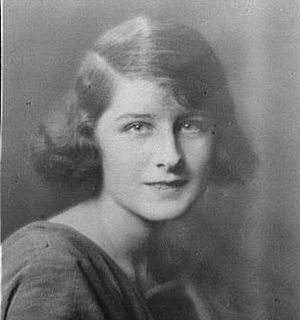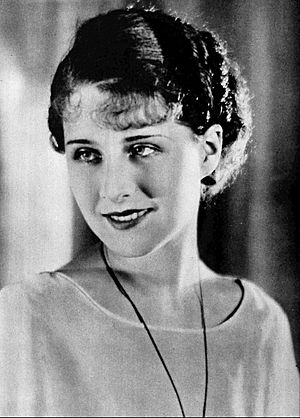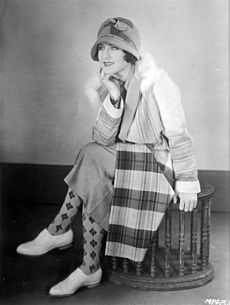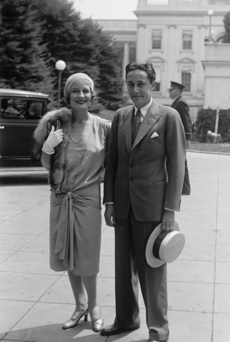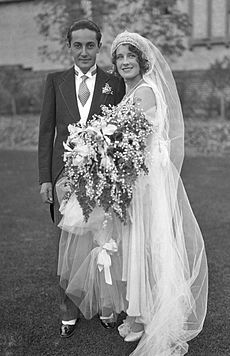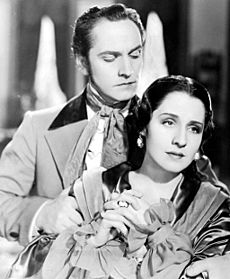Norma Shearer facts for kids
Quick facts for kids
Norma Shearer
|
|
|---|---|
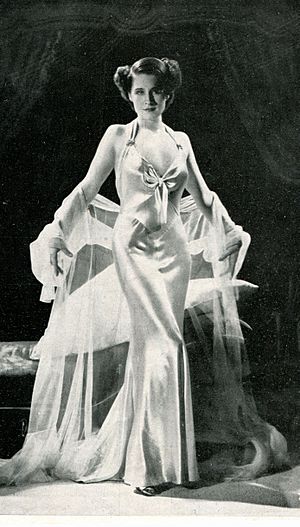
Shearer in Riptide (1934)
|
|
| Born |
Edith Norma Shearer
August 11, 1902 Montreal, Quebec, Canada
|
| Died | June 12, 1983 (aged 80) Los Angeles, California, U.S.
|
| Resting place | Forest Lawn Memorial Park, Glendale |
| Citizenship |
|
| Occupation | Actress |
| Years active | 1919–1950s |
| Political party | Republican |
| Spouse(s) |
Martin Arrougé
(m. 1942) |
| Children | 2, including Irving Thalberg Jr. |
| Parent(s) |
|
| Relatives | Athole Shearer (sister) Douglas Shearer (brother) Cresswell Shearer (uncle) |
Edith Norma Shearer (born August 11, 1902 – died June 12, 1983) was a Canadian-American actress. She starred in many films from 1919 to 1942. Norma often played innocent young women. She appeared in movies based on plays by famous writers like Noël Coward and William Shakespeare. She was the first actress to be nominated for five Academy Awards (Oscars). She won the award for Best Actress for her role in The Divorcee (1930).
Contents
Early Life and Dreams
Norma Shearer grew up in Montreal, Canada. Her family had roots in Scotland, England, and Ireland. Her father had a successful construction business, so her childhood was comfortable. However, her parents' marriage was not happy.
Norma was interested in music. But after seeing a vaudeville show (a type of stage entertainment) when she was nine, she decided she wanted to be an actress. Her mother, Edith, supported her dream. As Norma got older, she worried about her looks. Norma knew she had a "dumpy figure" and small eyes that sometimes looked crossed. But she was very ambitious and planned to overcome these challenges with hard work and charm.
In 1918, Norma's father's business failed, and her family lost their money. They had to move to a small house. This sudden poverty made Norma even more determined. She believed that even if a business failed, the person behind it didn't have to fail.
Soon after, her mother left her father and moved with her two daughters to a cheap boarding house. A few months later, Norma's uncle suggested she try acting in "the picture business" in New York City. Edith sold Norma's piano to buy train tickets to New York. She also got a letter of introduction for Norma to meet Florenz Ziegfeld, who created the famous Ziegfeld Follies shows.
Starting Her Career
New York City Struggles
In January 1920, Norma, her mother, and her sister arrived in New York. Norma felt excited and proud. But their rented apartment was very small and noisy. There was only one bed, a cot, and a tiny stove.
Meeting Florenz Ziegfeld was a big disappointment. He told Norma she wasn't pretty enough, criticizing her eyes and legs. But Norma didn't give up. She kept trying for acting jobs. She heard that Universal Pictures needed eight pretty girls as extras (background actors). Norma and her sister went, and there were 50 girls already there. Norma cleverly coughed loudly to get the casting director's attention. He laughed and picked her as the eighth girl.
She got other extra roles, including one in Way Down East, directed by D. W. Griffith. Norma tried to talk to Griffith about her dreams of becoming a star. But he told her her eyes were "no good" and too blue for close-ups. He said she would "never make it."
Still, Norma was determined. She spent some of her savings to see a doctor who specialized in eye problems. He gave her exercises to strengthen her eye muscles. After many years of daily practice, these exercises helped her hide her crossed eye on screen. She also spent hours practicing poses in front of a mirror to improve her appearance. At night, she watched famous actresses on Broadway to learn from them.
Norma also did some modeling work to earn money. She posed for many products, from laundry soap to tires. She even became "Miss Lotta Miles" for Kelly-Springfield Tires, appearing on a large billboard.
Moving to Hollywood
Finally, a year after arriving in New York, Norma got a bigger role in a movie called The Stealers (1920). In January 1923, she received an offer from Louis B. Mayer Pictures in Los Angeles. Irving Thalberg, a young and talented producer, had just joined the studio. He invited Norma to come to Hollywood. After three tough years, she signed a contract for $250 a week. She also got a chance to try out for a main role in a film called The Wanters.
Norma and her mother traveled to Los Angeles. Norma felt very confident, but when no one met her at the train station, she realized she wouldn't get special treatment.
The next morning, Norma met Irving Thalberg. She was impressed by his calm and strong personality. However, her first screen test (a short film to see how an actor looks on camera) was terrible. The bright lights made her eyes look white and her nose disappear, making her look cross-eyed.
Norma was very upset. A cameraman named Ernest Palmer saw how disappointed she was. He agreed that the test was poorly done. Under his guidance, they made a second test, which was much better. Norma seemed to have the lead role in The Wanters, but the director thought she wasn't "photogenic" (didn't look good on camera). So, she got a smaller role instead.
Her next role was in Pleasure Mad. Norma knew this was her last chance. She struggled at first, but then she gave an amazing performance in an emotional scene. This earned her the respect of the director and the studio. As a reward, Thalberg cast her in six films in eight months.
Becoming a Star at MGM
On April 26, 1924, Louis B. Mayer Pictures joined with other studios to form Metro-Goldwyn-Mayer (MGM). Norma Shearer starred in MGM's first official movie, He Who Gets Slapped, with Lon Chaney and John Gilbert. The film was a big success and helped MGM become a major studio. It also made Norma very famous. By late 1925, she was a true star, carrying her own films. She signed a new contract, earning $1,000 a week, which would increase to $5,000 over five years. She bought a house for herself and her mother near the Hollywoodland sign.
Norma and Irving Thalberg
As a star, Norma faced a new challenge: staying famous. Many other talented actresses were at MGM, like Greta Garbo. Norma often visited Thalberg's office to ask for better movie roles. He would listen patiently and tell her that MGM knew best. Sometimes, Norma would cry, but it didn't seem to bother him.
However, Thalberg was secretly very impressed by Norma. In July 1925, he invited her to the premiere of Chaplin's The Gold Rush. This was their first public appearance as a couple. A few weeks later, Norma told an old school friend that she was "madly in love" with Irving Thalberg and hoped to marry him.
By 1927, Norma had made 13 silent films for MGM. Each one was a big success, making a lot of money for the studio. As a reward, she was cast in The Student Prince in Old Heidelberg, a big-budget film. While finishing this movie, Thalberg called her to his office. He showed her a tray of diamond engagement rings and let her choose one. She picked the biggest one! In August 1927, they announced their engagement, and on September 29, 1927, they had a grand Hollywood wedding. Norma and Irving had two children: Irving Jr. (born 1930) and Katherine (born 1935). Before they married, Norma converted to Judaism to be with Thalberg.
The Era of Talkies
One week after their wedding, The Jazz Singer was released. This was the first full-length movie with sound, and it changed filmmaking forever. Many silent film actors lost their careers, but Norma was determined not to be one of them. Her brother, Douglas Shearer, helped develop sound technology at MGM, and they prepared Norma carefully for the microphone.
Her first "talkie" (movie with sound), The Trial of Mary Dugan (1929), was a huge success. Critics praised Norma's clear and flexible voice. Other actresses even tried to copy her Canadian accent. Even though her next talking films were popular, Norma worried that audiences would get tired of her "good girl" image. She took new photos that convinced her husband she could play the lead in MGM's daring new film, The Divorcee (1930).
Award-Winning Roles
Norma won an Academy Award for Best Actress for The Divorcee. After this, she starred in a series of very successful films made before strict movie rules were enforced (these were called "pre-Code" films). These included Let Us Be Gay (1930), Strangers May Kiss (1931), A Free Soul (1931) with Clark Gable, and Private Lives (1931). These movies made her one of MGM's top actresses, competing with stars like Joan Crawford and Greta Garbo.
Norma's marriage to Irving Thalberg gave her a lot of power in Hollywood. Some rival actresses complained that she always got the best roles.
Her pre-Code films included historical dramas and plays adapted for the screen. Smilin' Through (1932) was very successful. Strange Interlude (1932), also starring Clark Gable, was a big hit because it showed off Norma's acting skills.
The First Lady of MGM
In 1934, new strict rules called the Production Code were enforced for movies. This meant Norma had to change her "free soul" image. She started focusing on historical dramas and "prestige" films. The Barretts of Wimpole Street (1934) was her most successful film during this time. She also starred in Romeo and Juliet (1936) and Marie Antoinette (1938). These films had beautiful sets and costumes, making them very popular with audiences.
Norma Shearer was nominated for an Academy Award for Best Actress six times. She won once for The Divorcee in 1930. She was also nominated for Their Own Desire (1930), A Free Soul (1931), The Barretts of Wimpole Street (1934), Romeo and Juliet (1936), and Marie Antoinette (1938).
In 1939, she tried a different kind of role in the comedy Idiot's Delight. This was her last film with Clark Gable. She then starred in The Women (1939), which had an all-female cast of over 130 speaking roles.
Norma was considered for the role of Scarlett O'Hara in Gone With The Wind (1939). But she wasn't interested, joking that she'd rather play Rhett!
Her next film, Escape (1940), was a suspenseful movie about a woman helping an American free his mother from a concentration camp. It did well at the box office. However, her later films, We Were Dancing and Her Cardboard Lover (1942), were not successful. In 1942, Norma Shearer decided to retire from acting.
Later Life and Legacy
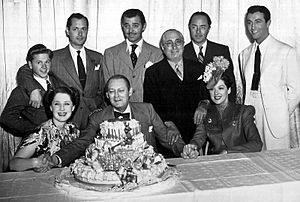
Irving Thalberg passed away unexpectedly on September 14, 1936. After his death, Norma made sure that his family still received money from the films he had worked on at MGM. She continued to act for a few more years.
After retiring in 1942, Norma married Martin Arrougé (born 1914 – died 1999). He was a Navy pilot during World War II and had been a ski instructor for her children. He was 11 years younger than her. Norma gradually stepped away from the Hollywood social scene. She and Martin remained married until her death.
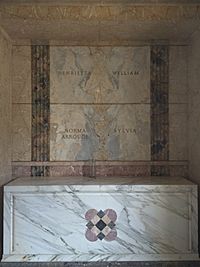
Norma Shearer died on June 12, 1983, from pneumonia. She was 80 years old. She is buried in the Great Mausoleum at Forest Lawn Memorial Park, Glendale in California, next to her first husband, Irving Thalberg. Her crypt is marked Norma Arrouge.
Norma Shearer's fame faded a bit after she retired. But in the late 1950s, her films were shown on television, and in the 1970s, they were shown again in theaters. By the time she died, she was best known for her roles in Marie Antoinette and The Women.
A new interest in Norma Shearer's work began in 1988 when her films were shown on TV channels like Turner Network Television and Turner Classic Movies. People started to appreciate her earlier "pre-Code" films more.
Norma Shearer was known for controlling her work and helping other artists. She also helped discover actress Janet Leigh and actor-producer Robert Evans.
For her contributions to movies, Norma Shearer has a star on the Hollywood Walk of Fame. In 2008, Canada Post issued a postage stamp to honor her. She was also inducted into Canada's Walk of Fame in 2008.
Awards and Nominations
Norma Shearer was the first person to receive five Academy Award nominations for acting. She and her brother Douglas Shearer were the first siblings to both win Oscars.
| Year | Award | Film | Result |
|---|---|---|---|
| 1930 | Academy Award for Best Actress | Their Own Desire | Nominated |
| The Divorcee | Won | ||
| 1931 | A Free Soul | Nominated | |
| 1934 | The Barretts of Wimpole Street | Nominated | |
| 1936 | Romeo and Juliet | Nominated | |
| 1936 | New York Film Critics Circle Award for Best Actress (3rd) | Nominated | |
| 1938 | Academy Award for Best Actress | Marie Antoinette | Nominated |
| 1938 | Venice Film Festival – Volpi Cup for Best Actress | Won |
Filmography
Radio Appearances
| Year | Program | Episode/source |
|---|---|---|
| 1941 | Gulf Screen Guild Theatre | No Time for Comedy |
| 1951 | Screen Directors Playhouse | Waterloo Bridge |
See Also
 In Spanish: Norma Shearer para niños
In Spanish: Norma Shearer para niños
- List of actors with Academy Award nominations


